Abstract
Oxygen induces superoxide dismutase in Streptococcus faecalis and in Escherichia coli B. S. faecalis grown under 20 atm of O2 had 16 times more of this enzyme than did anaerobically grown cells. In the case of E. coli, changing the conditions of growth from anaerobic to 5 atm of O2 caused a 25-fold increase in the level of superoxide dismutase. Induction of this enzyme was a response to O2 rather than to pressure, since 20 atm of N2 was without effect. Induction of superoxide dismutase was a rapid process, and half of the maximal level was reached within 90 min after N2-grown cells of S. faecalis were exposed to 20 atm of O2 at 37 C. S. faecalis did not contain perceptible levels of catalase under any of the growth conditions investigated by Stanier, Doudoroff, and Adelberg (23), and the concentration of catalase in E. coli was not affected by the presence of O2 during growth. S. faecalis, which had been grown under 100% O2 and which therefore contained an elevated level of superoxide dismutase, was more resistant of 46 atm of O2 than were cells which had been grown under N2. E. coli grown under N2 contained as much superoxide dismutase as did S. faecalis grown under 1 atm of O2. The E. coli which had been grown under N2 was as resistant to the deleterious effects of 50 atm of O2 as was S. faecalis which had been grown under 1 atm of O2. These results are consistent with the proposal that the peroxide radical is an important agent of the toxicity of oxygen and that superoxide dismutase may be a component of the systems which have been evolved to deal with this potential toxicity.
Full text
PDF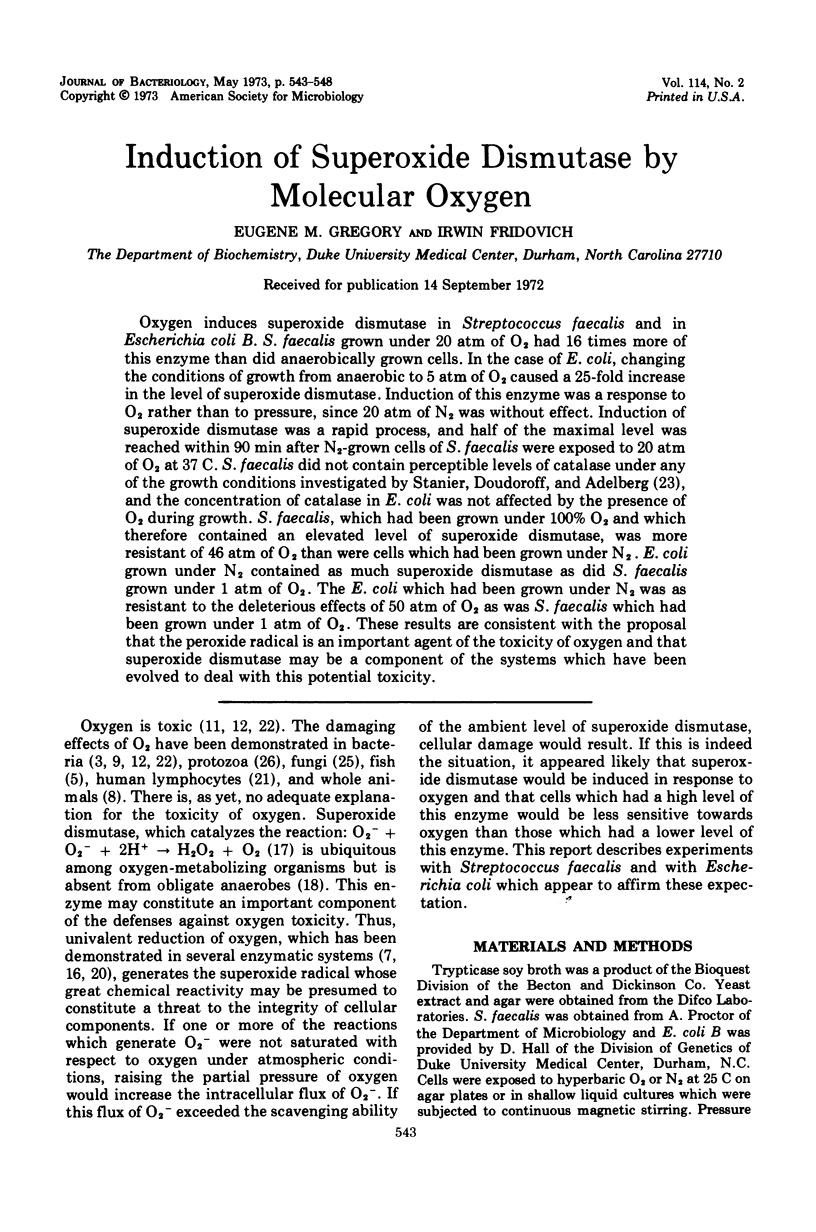
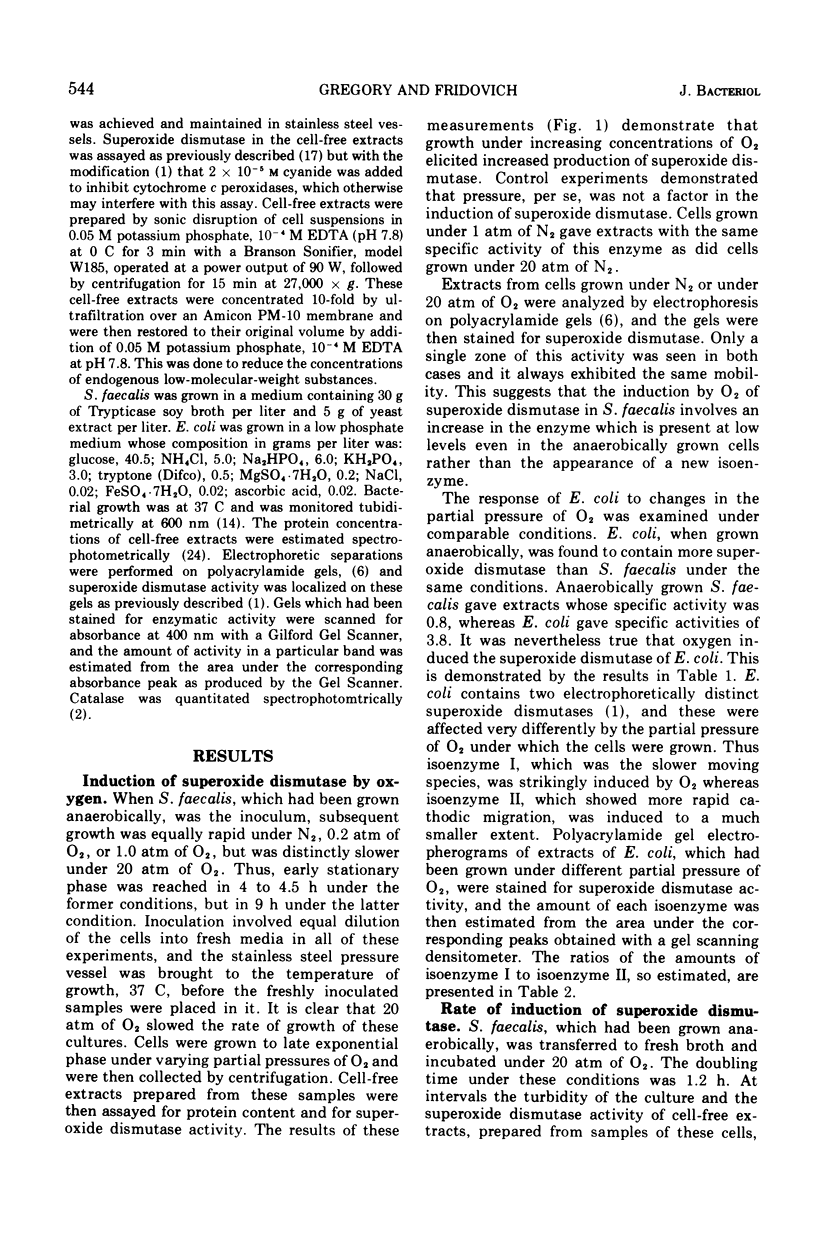
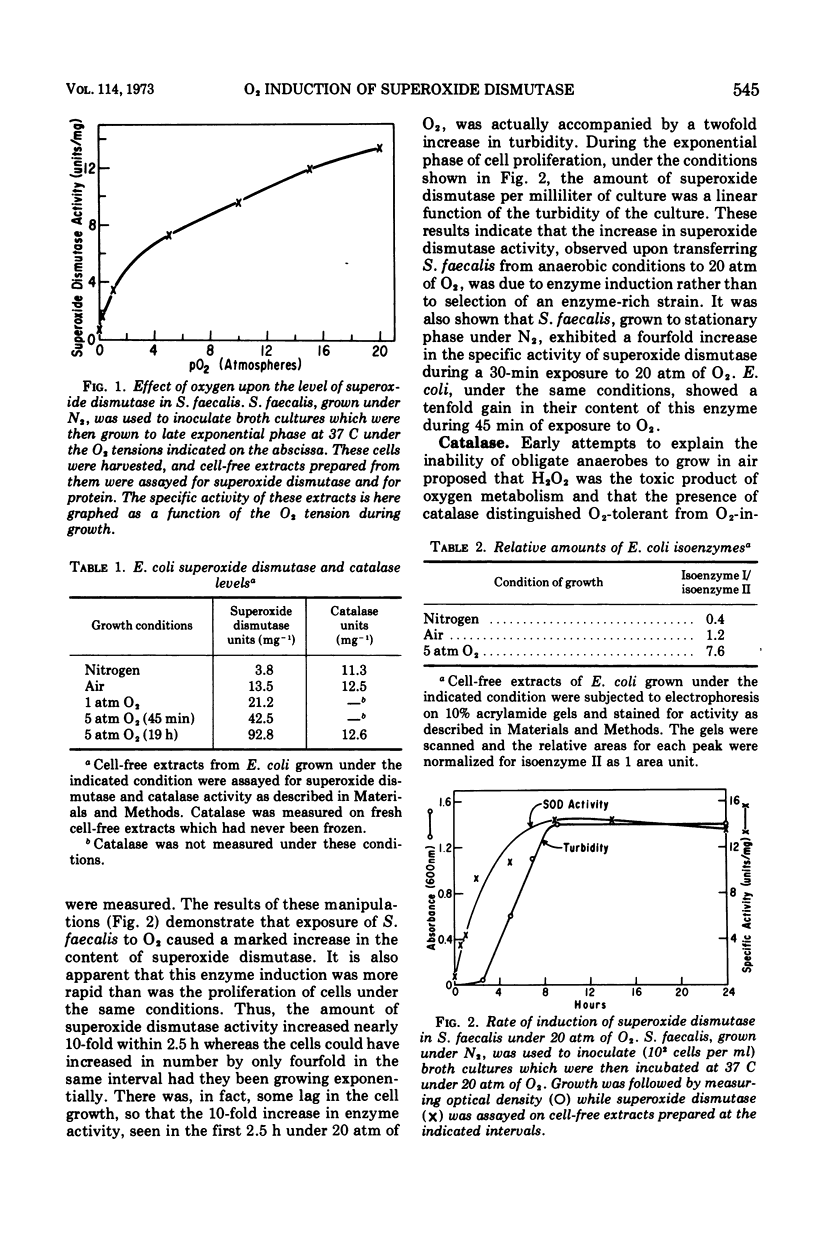
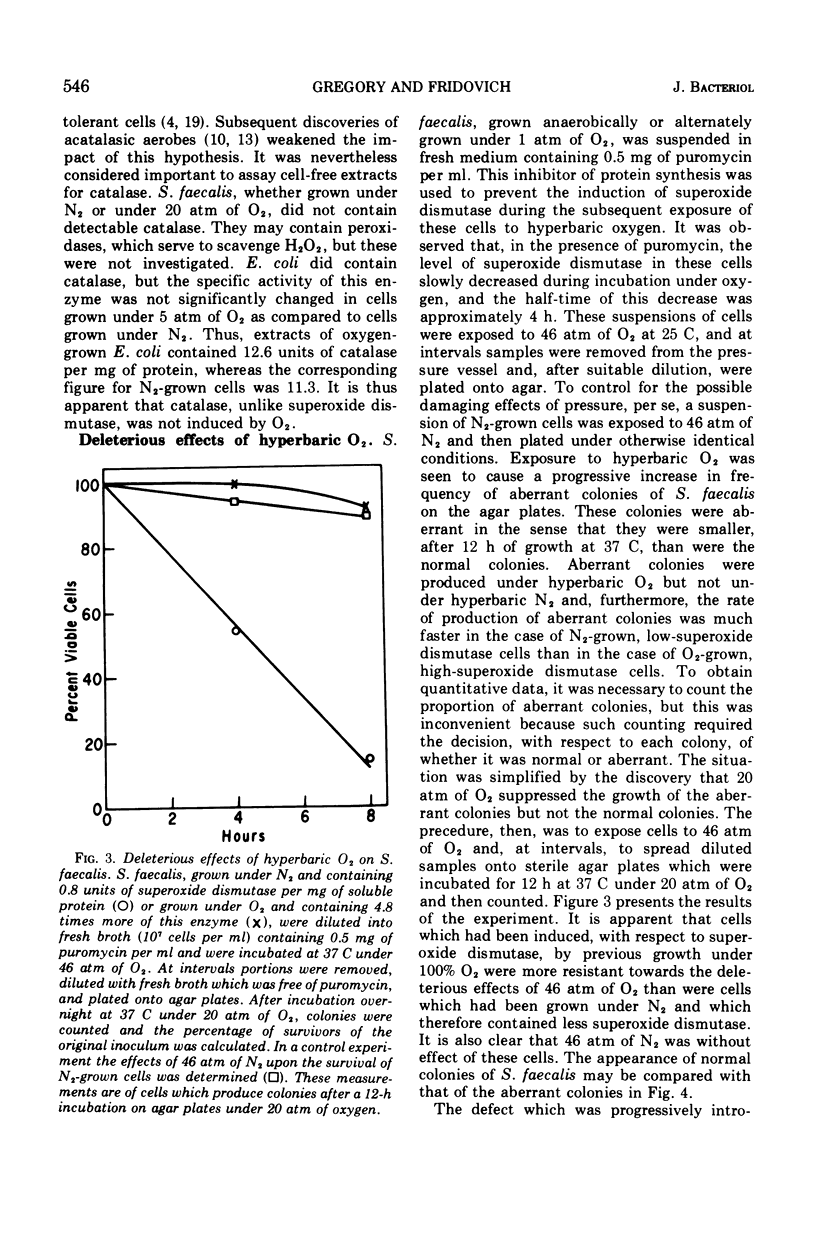
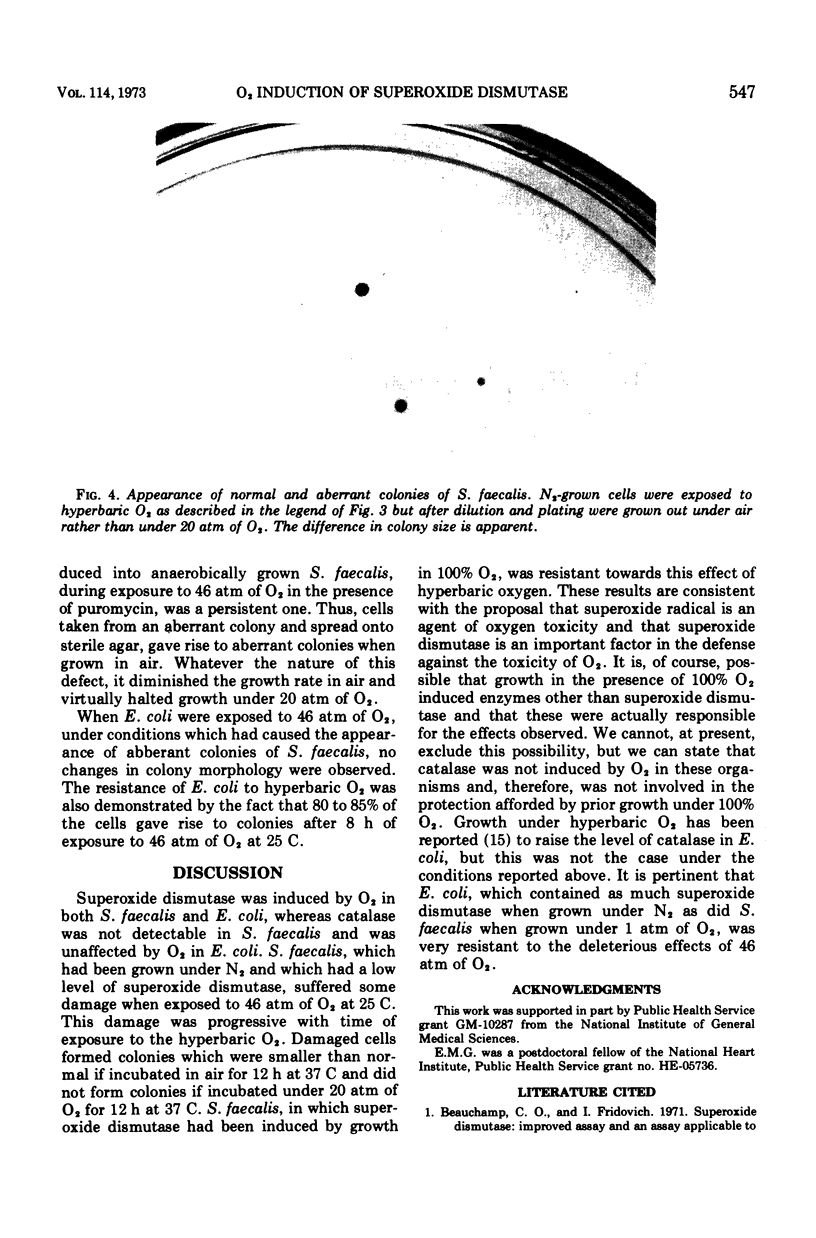
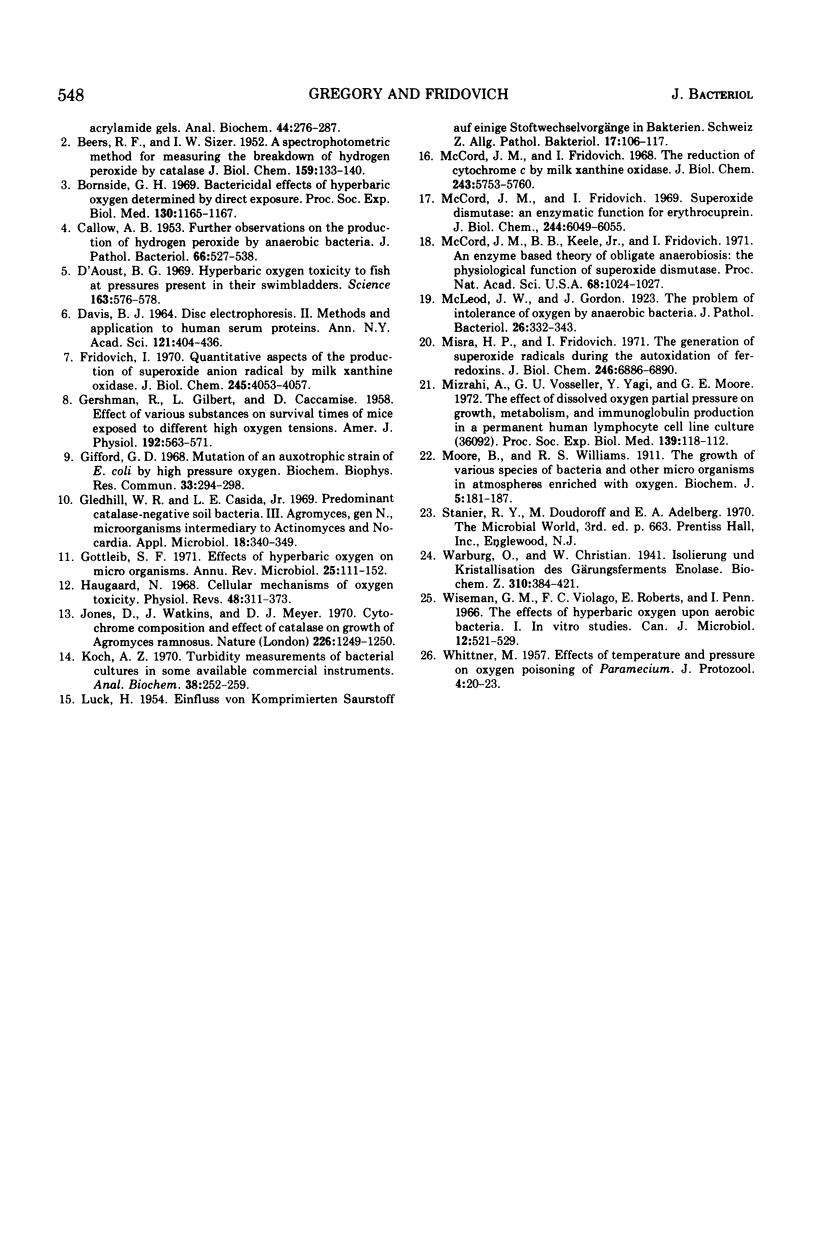
Images in this article
Selected References
These references are in PubMed. This may not be the complete list of references from this article.
- BEERS R. F., Jr, SIZER I. W. A spectrophotometric method for measuring the breakdown of hydrogen peroxide by catalase. J Biol Chem. 1952 Mar;195(1):133–140. [PubMed] [Google Scholar]
- Bornside G. H. Bactericidal effect of hyperbaric oxygen determined by direct exposure. Proc Soc Exp Biol Med. 1969 Apr;130(4):1165–1167. doi: 10.3181/00379727-130-33744. [DOI] [PubMed] [Google Scholar]
- D'Aoust B. G. Hyperbaric oxygen: toxicity to fish at pressures present in their swimbladders. Science. 1969 Feb 7;163(3867):576–578. doi: 10.1126/science.163.3867.576-a. [DOI] [PubMed] [Google Scholar]
- DAVIS B. J. DISC ELECTROPHORESIS. II. METHOD AND APPLICATION TO HUMAN SERUM PROTEINS. Ann N Y Acad Sci. 1964 Dec 28;121:404–427. doi: 10.1111/j.1749-6632.1964.tb14213.x. [DOI] [PubMed] [Google Scholar]
- Fridovich I. Quantitative aspects of the production of superoxide anion radical by milk xanthine oxidase. J Biol Chem. 1970 Aug 25;245(16):4053–4057. [PubMed] [Google Scholar]
- GERSCHMAN R., GILBERT D. L., CACCAMISE D. Effect of various substances on survival times of mice exposed to different high oxygen tensions. Am J Physiol. 1958 Mar;192(3):563–571. doi: 10.1152/ajplegacy.1958.192.3.563. [DOI] [PubMed] [Google Scholar]
- GORDON J., HOLMAN R. A., McLEOD J. W. Further observations on the production of hydrogen peroxide by anaerobic bacteria. J Pathol Bacteriol. 1953 Oct;66(2):527–537. doi: 10.1002/path.1700660224. [DOI] [PubMed] [Google Scholar]
- Gifford G. D. Mutation of an auxotrophic strain of Escherichia coli by high pressure oxygen. Biochem Biophys Res Commun. 1968 Oct 24;33(2):294–298. doi: 10.1016/0006-291x(68)90783-3. [DOI] [PubMed] [Google Scholar]
- Gledhill W. E., Casida L. E. Predominant Catalase-negative Soil Bacteria. III. Agromyces, gen. n., Microorganisms Intermediary to Actinomyces and Nocardia. Appl Microbiol. 1969 Sep;18(3):340–349. doi: 10.1128/am.18.3.340-349.1969. [DOI] [PMC free article] [PubMed] [Google Scholar]
- Gottlieb S. F. Effect of hyperbaric oxygen on microorganisms. Annu Rev Microbiol. 1971;25:111–152. doi: 10.1146/annurev.mi.25.100171.000551. [DOI] [PubMed] [Google Scholar]
- Haugaard N. Cellular mechanisms of oxygen toxicity. Physiol Rev. 1968 Apr;48(2):311–373. doi: 10.1152/physrev.1968.48.2.311. [DOI] [PubMed] [Google Scholar]
- Jones D., Watkins J., Meyer D. J. Cytochrome composition and effect of catalase on growth of Agromyces ramnosus. Nature. 1970 Jun 27;226(5252):1249–1250. doi: 10.1038/2261249a0. [DOI] [PubMed] [Google Scholar]
- Koch A. L. Turbidity measurements of bacterial cultures in some available commercial instruments. Anal Biochem. 1970 Nov;38(1):252–259. doi: 10.1016/0003-2697(70)90174-0. [DOI] [PubMed] [Google Scholar]
- LUCK H. Einfluss von komprimiertem Sauerstoff auf einige Stoffwechselvorgänge in Bakterien. Schweiz Z Pathol Bakteriol. 1954;17(1):106–117. [PubMed] [Google Scholar]
- McCord J. M., Fridovich I. Superoxide dismutase. An enzymic function for erythrocuprein (hemocuprein). J Biol Chem. 1969 Nov 25;244(22):6049–6055. [PubMed] [Google Scholar]
- McCord J. M., Fridovich I. The reduction of cytochrome c by milk xanthine oxidase. J Biol Chem. 1968 Nov 10;243(21):5753–5760. [PubMed] [Google Scholar]
- McCord J. M., Keele B. B., Jr, Fridovich I. An enzyme-based theory of obligate anaerobiosis: the physiological function of superoxide dismutase. Proc Natl Acad Sci U S A. 1971 May;68(5):1024–1027. doi: 10.1073/pnas.68.5.1024. [DOI] [PMC free article] [PubMed] [Google Scholar]
- Misra H. P., Fridovich I. The generation of superoixide radical during the autoxidation of ferredoxins. J Biol Chem. 1971 Nov 25;246(22):6886–6890. [PubMed] [Google Scholar]
- Mizrahi A., Vosseller G. V., Yagi Y., Moore G. E. The effect of dissolved oxygen partial pressure on growth, metabolism and immunoglobulin production in a permanent human lymphocyte cell line culture. Proc Soc Exp Biol Med. 1972 Jan;139(1):118–122. doi: 10.3181/00379727-139-36092. [DOI] [PubMed] [Google Scholar]
- Moore B., Williams R. S. The Growth of Various Species of Bacteria and Other Micro-Organisms in Atmospheres Enriched with Oxygen. Biochem J. 1911;5(4):181–187. doi: 10.1042/bj0050181. [DOI] [PMC free article] [PubMed] [Google Scholar]
- Violago F. C., Roberts E., Penn I. The effect of hyperbaric oxygen upon aerobic bacteria. I. In vitro studies. Can J Microbiol. 1966 Jun;12(3):521–529. doi: 10.1139/m66-075. [DOI] [PubMed] [Google Scholar]



